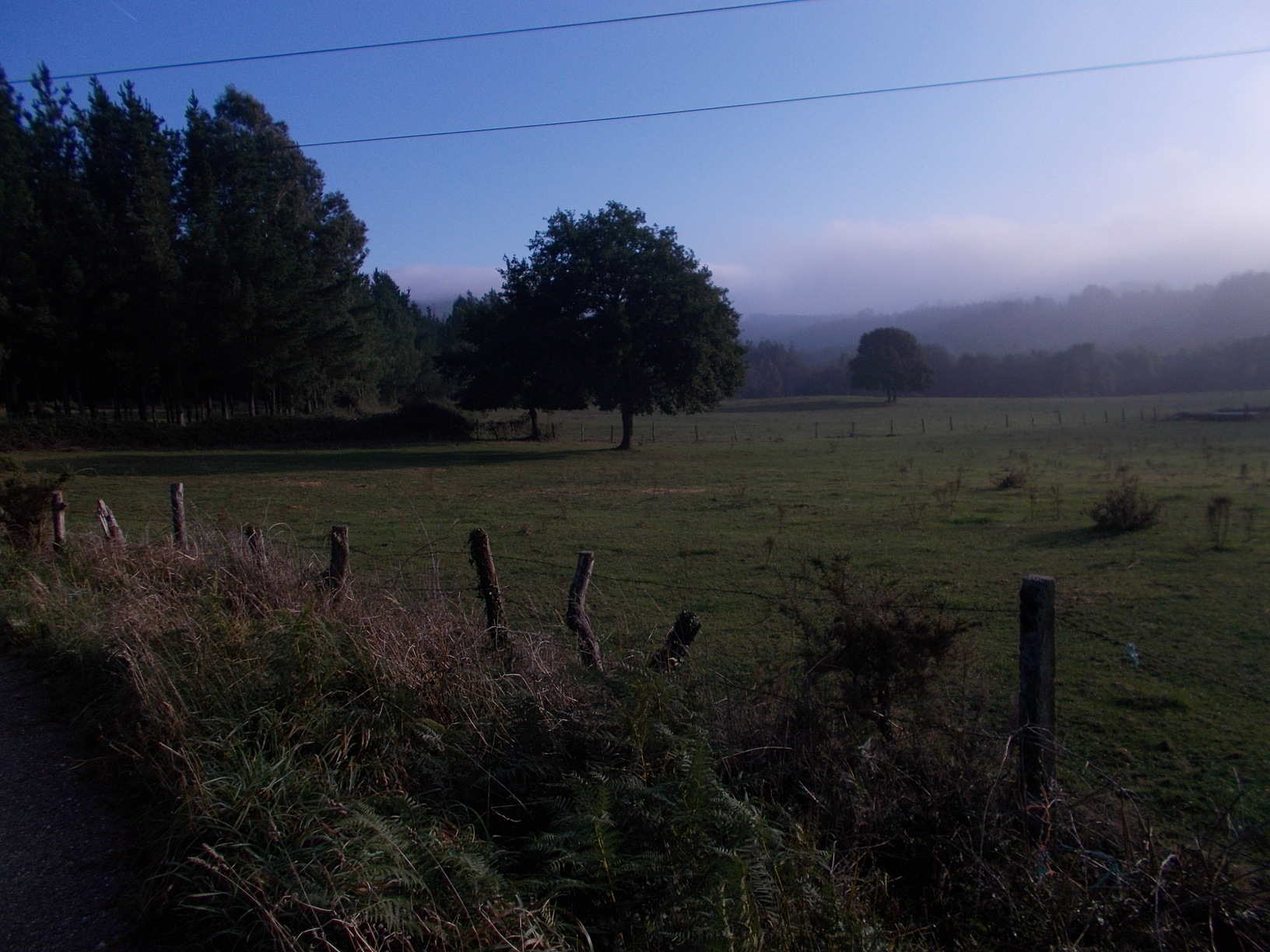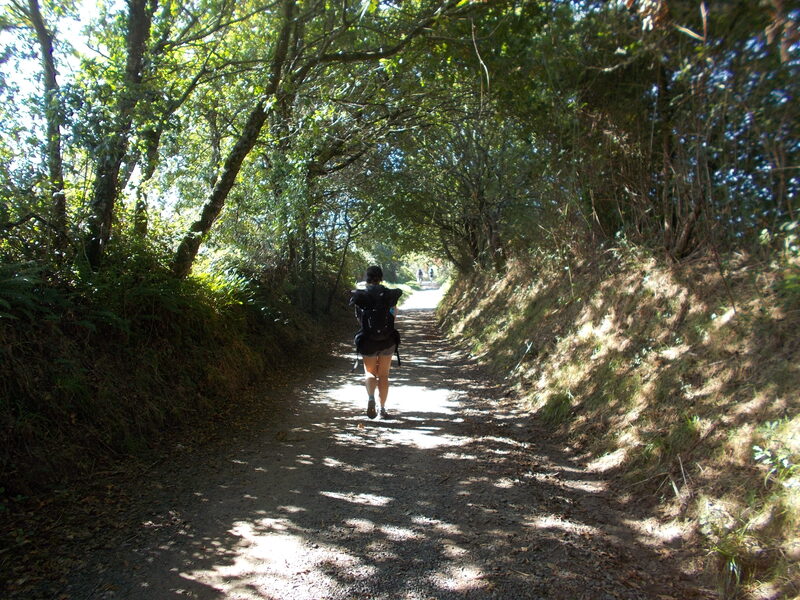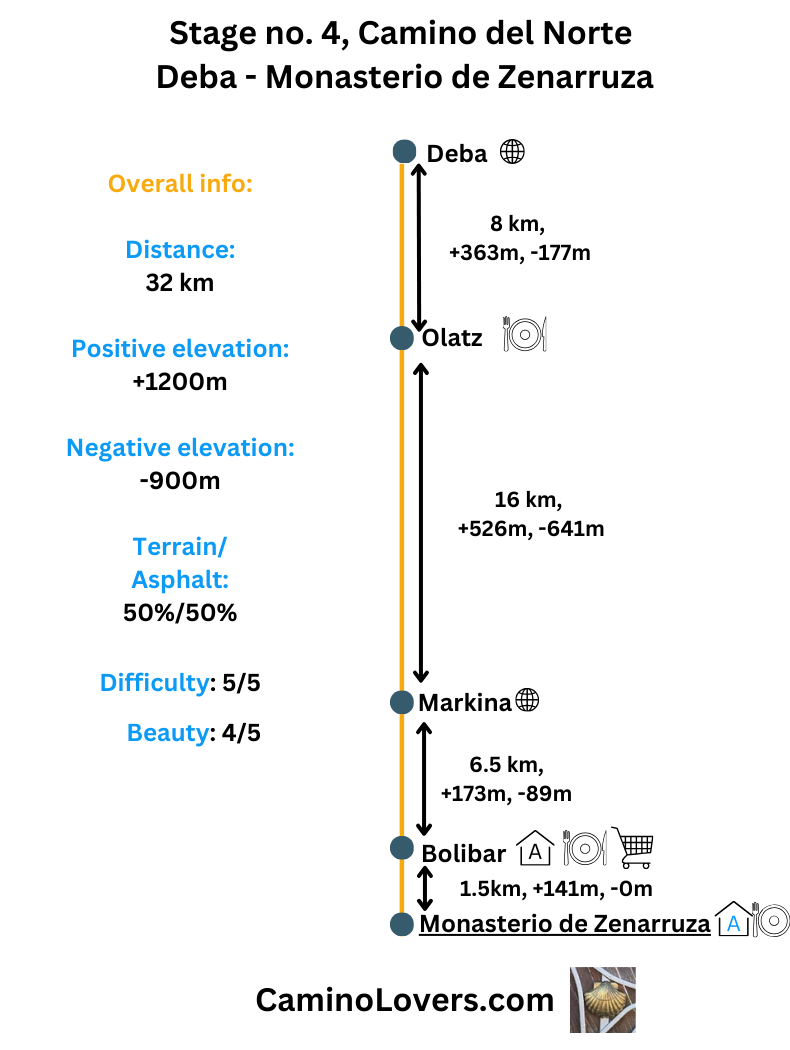
Basic Details
- Starting point: Church of Santa Maria, Deba.
- Ending point: Monastery (with an albergue) Monasterio de Zenarruza.
- Availability of alternative routes: YES, there is a small alternative route over the mountains, following the GR 121 marked trail. Following this route you will save about 3 kilometers of walking distance, and the elevation is just about the same. I would not say that this route is spectacular in any way, but it isn’t a bad one either. There is one mountain hut (Arnoko Arteapa, not staffed) along the alternative way, always open, where you can sleep in theory if you decide following a different itinerary on your Camino. Bear in mind that you won’t find any provisions in the hut–you need to have your own food.
- Distance: Official camino route: 32 km (download GPS here), Alternative route, 29 km (download GPS here).
- Link to online map: Official camino route: here. Alternative route: here.
- Elevation difference: Official camino route: + 1203m, – 907m, Alternative route: + 1184m, – 895m
- Difficulty score: Official Camino route 5/5. Alternative route: 5/5.
- Beauty score: Official Camino route: 4/5. Alternative route: 4/5.
- Terrain/asphalt: Official Camino route: 50%/50% , Alternative route: 65%/35%.
- Next stage: Camino del Norte, Stage no. 5, from Monasterio de Zenarruza to Gerekiz.
- Previous stage: Camino del Norte, Stage no. 3, from Zarautz to Deba.
Elevation profiles for routes
 – “Official camino way”, lot of climbing today, including a final push to the monastery, something a tired pilgrim may easily struggle with :).
– “Official camino way”, lot of climbing today, including a final push to the monastery, something a tired pilgrim may easily struggle with :).
 – Alternative Camino way over the mountain hut, climbing close to 600 meters on the first 7.5 kilometers, but then the rest of the way is relatively easy, except of the last climb to the monastery (with an albergue).
– Alternative Camino way over the mountain hut, climbing close to 600 meters on the first 7.5 kilometers, but then the rest of the way is relatively easy, except of the last climb to the monastery (with an albergue).
Advanced info about the stage
- Trail marking: Overall very good in this stage. In many ways this is an atypical stage on Camino del Norte, since you won’t see the coast all day long. It takes you through nice forests and green parts of Basque country, and typically there is just one way to follow. The potential wrong turns are virtually all protected with fences and marked as private property. The alternative way over the mountain hut is very well sign-posted with red and yellow marks.
- Alternative route info: It is perhaps worth taking, since it will save you both some distance and elevation. It isn’t spectacular, and one short part is rocky and can be extremely slippery in bad weather, but it isn’t a bad one either, and a nice way to escape the crowds and perhaps see something different, like the mountain shelter Arnoko Arteapa, located in a very atypical spot in low mountains (until this day I quite haven’t figured out why the shelter is located here :)).
- Natural places worth seeing: Nothing worth mentioning in particular. However, the entire stage takes you through Basque countryside, very sparsely populated and traversed only by few locals and pilgrims. This is not a touristic part of the country, and it is something you should enjoy, because on many days you will pass through areas dominated by tourists. On a rainy day the air is just wonderful, with plenty of eucalyptus and other trees providing a pleasant and almost healing fragrance.
- Historical, architectural, and culinary places worth seeing: First of all, the church in Markina–Ermita de San Miguel (see pictures below), with it’s famous huge rock inside the church. I’ve probably never seen something similar… There’s no entrance fee, and it is directly on the Camino, so definitely a must to see. And than the final point of the way, the Monasterio de Zenarruza, which is a beautiful complex of buildings worth exploring, located inside nice nature. On the top of that the evening prayers of monks (that take place every day) are worth visiting, even if you’re not a Christian.
- Camping/bivouac options on this stage: Looking on a map, this is definitely one of the most misleading stages when it comes to wild camping/bivouacking options. It seems like you are passing through the woods and countryside, and will have a chance to camp almost everywhere. However, most of the way follows a route that is protected by fences on both sides, and the forest around is pretty dense anyway, with little options of pitching the tent. On the official camino way there isn’t a single bench or shelter in the mid part of this stage, between Ermita del Calvario and Markina. If you want to camp or bivouac, I suggest you to follow the alternative route following the GR 121 in the central part (you can download the GPS for this variant here), and stay in the mountain shelter, or camp close to it. You will also find some fitting spots near the monastery at the very end of the stage. However, it is much better asking the monks for the place to stay, since they are always able to come up with more room for pilgrims within their premises…
- Dog friendly score: 4/5. Generally speaking this is a really good stage for dogs. Not many people, the parts on the road follows roads with virtually no cars, and then you spend a lot of time in the forests. And while there aren’t any drinking fountains for pilgrims on this part of the trail, there are plenty of puddles of water and generally always enough water for the dog to drink and refresh itself. The albergue in the monastery is also dog friendly, and they will find a place for your dog to stay.
- Special remarks:
- It may be tempting to think that since you pass through the forest, there will be lot of drinking water available. And while there are some fountains known by the locals, you won’t really pass by any on your Camino. Hence make sure to take enough water with you, to have sufficient quantity at least until you reach Markina.
- There are no benches or other good places for rest whatsoever in the middle part of the stage (the forest part). Hence on a rainy day there isn’t really a good spot to sit and have a rest. This is something you may consider while planning your walk and the stops you want to make.
- Other websites say that the capacity of the albergue in the monastery (the end of this stage) is 21 beds. However, I’ve seen more than 40 people staying there on the night… The monks try to be really helpful to the pilgrims, and will always find some extra spots to sleep. Hence you do not have to be that worried of arriving there early enough.
- They brew a craft beer at the monastery, called Cerveza Monacal Ziortza. You can buy it in the local shop at the monastery, and for good beer lovers it is a must try :).
Accommodation options on today’s stage
* The infographic displays the number of pilgrim hostels (only pilgrims allowed), hostels (anyone allowed, shared rooms), and other accommodation options (hotels, pensions, etc, private rooms) in each point along the route, together with price range. For exact explanation of the pictograms we use check the explanations page. Below the infographic you will see our recommended picks (up to 3 pilgrim options and 1-2 “privacy” options, maximum five) for the stage, together with important information (but not too much info, just what you need :-)).

Recommended places to sleep along this stage
Pilgrim options:
- Albergue Izarbide aterpetxea, Izarbide (km 5). Location and reviews on Google maps here. A salvation for many people on budget who do not get a bed in the albergue in Deba. 5 kilometers on, and on the hill, in an isolated place with no services. Price 20 euro/night, 32 beds, option for an evening meal. Check-in from 3pm to 7pm. Recommended reservation method: phone call, +34655459769.
- Albergue-Casa Rural Intxauspe, Markina (km 24). Location and reviews on Google maps here. A typical Basque country house with beautiful architecture and garden. Due to the stone construction it doesn’t get too warm inside even in the height of the summer. 20 beds in a shared room (a big one), and 6 private rooms. They offer dinner and breakfast at extra cost. The bed is 14-16 euro/night, depending on the season. Check-in time from 3pm. Great reviews across different platforms. Recommended booking method: by phone, +34 652 770 889, or +34 658 758 617.
- Albergue de peregrinos del Monasterio de Zenarruza, Mon. de Zenarruza (km 32). Location and reviews on Google maps here. Donation based, officially 21 beds but they always find place for many more pilgrims (if needed). Simple communal dinner, vegan. A great place to stay, definitely the best on this stage. Special location, spirit of the place, and a chance to sleep in the premises of a monastery for one night. Reservations are not accepted.
Privacy/Luxury options
- Arriaga 1, Markina (km 24). Private apartment, location on Google maps here. Excellent reviews, up to 4 people, price from 100 euro/night for the entire apartment, check-in from 3 pm to 10 pm, almost all guests are pilgrims.Recommended booking option: booking.com.
Pictures from the stage

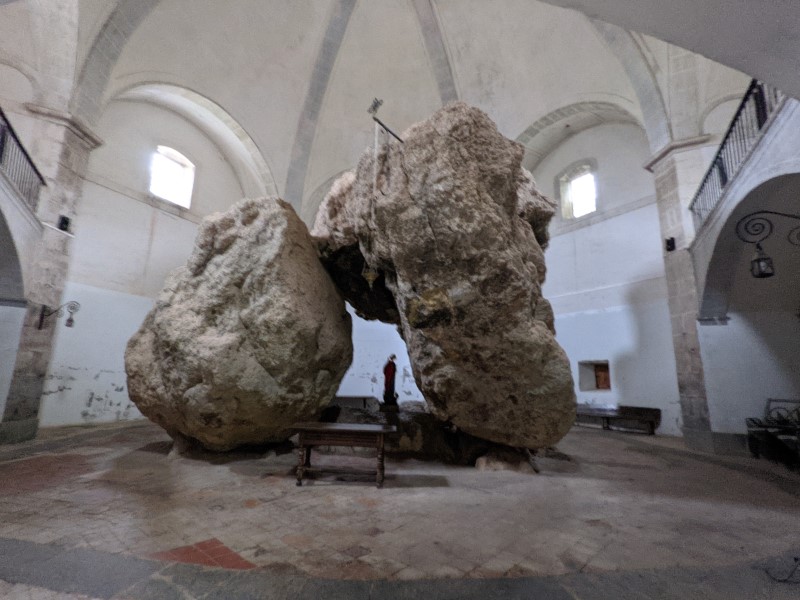


Few tips at the end
- Do not underestimate the difficulty of this stage. I’ve witnessed quite a few pilgrims having to take taxi from Markina to the monastery, since they arrived so late and were too tired for the last final climb. This stage has 1,200 meters of positive elevation, and I can assure you that’s not a little number for anyone, especially carrying a big backpack.
- If you can, try to stay at the albergue run by the monastery. It is a kind of a special experience, and you won’t have many options to sleep in similar places on your Camino (perhaps 2 or 3 more, you’ll find the information always in the stage guide here).
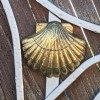



![Ultralight Packing List for Camino de Santiago [2025 Edition]](https://caminolovers.com/wp-content/uploads/2022/03/altra-shoes-640-x-480.jpg)

